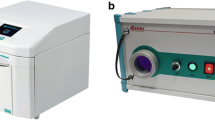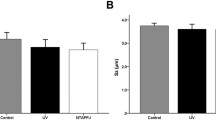Abstract
Ultraviolet (UV) irradiation has been proposed as a method to reverse the aging process of titanium. However, the intensity, exposure time and wavelength that provide the best results have not yet been determined. The objective of this study was to evaluate the effects of photocatalysis by ultraviolet C light on the time-dependent aging of titanium and to analyze the irradiated titanium for changes in structure and in vitro biological activity, with regard to different exposure times. A titanium photofunctionalization device was developed with characteristics different from those on the market. The sample was composed of titanium disks irradiated for different times of exposure to ultraviolet C light (0, 15, 30 and 60 min). The disks were tested for surface wettability (water contact angle), topography (scanning electron microscopy—SEM) and chemical composition (X-ray photoelectron spectroscopy), and effects on cell adhesion (cell culture and SEM) and cell viability by sulforhodamine B (SRB). Ultraviolet C treatment caused changes in titanium surface characteristics, such as increased wettability and removal of hydrocarbons from the surface after 15 min of exposure in the chamber developed. The biological characteristics of the material also appear to have changed, with improved cell adhesion and viability. Photofunctionalization of titanium proved to be effective for the treatment of aged surfaces, with significant modifications in the surface chemical structure and biological activity of the material.







Similar content being viewed by others
References
Brånemark PI, Rydevik BL, Skalak R. Osseointegration in skeletal reconstruction and joint replacement. Carol Stream, IL: Quintessence Publishing Co; 1997.
Beltrán-Partida E, Valdéz-Salas B, Moreno-Ulloa A, Escamilla A, Curiel MA, Rosales-Ibáñez R, Villarreal F, Bastidas DM, Bastidas JM. Improved in vitro angiogenic behavior on anodized titanium dioxide nanotubes. J Nanobiotechnology. 2017;15:1–10. https://doi.org/10.1186/s12951-017-0247-8.
Grischke J, Eberhard J, Stiesch M. Antimicrobial dental implant functionalization strategies -a systematic review. Dent Mater J. 2016;35(4):545–58. https://doi.org/10.4012/dmj.2015-314(PubMed PMID: 27477219).
Saghiri MA, Asatourian A, Garcia-Godoy F, Sheibani N. The role of angiogenesis in implant dentistry part I: Review of titanium alloys, surface characteristics and treatments. Med Oral Patol Oral Cir Bucal. 2017;21(4):514–25 (PubMed PMID: 27031073; PubMed Central PMCID: PMC4920467).
Schliephake H. Functionalization of titanium implants using a modular system for binding and release of VEGF enhances bone-implant contact in a rodent model. J Clin Periodontol. 2015;42:302–10. https://doi.org/10.1111/jcpe.12370.
Att W, Hori N, Takeuchi M, Ouyang J, Yang Y, Anp M, Ogawa T. Time-dependent degradation of titanium osteoconductivity: an implication of biological aging of implant materials. Biomaterials. 2017;30(29):5352–63.
Lee JH, Ogawa T. The biological aging of titanium implants. Implant Dent. 2012;21(5):415–21.
Ogawa T. Ultraviolet photofunctionalization of titanium implants. Int J Oral Maxillofac Implants. 2014;29(1):95–102.
Roy M, Pompella A, Kubacki J, Szade J, Roy RA, Hedzelek W. Photofunctionalization of titanium: an alternative explanation of its chemical-physical mechanism. PLoS ONE. 2016;11:6. https://doi.org/10.1371/journal.pone.0157481.
Aita H, Hori N, Takeuchi M, Suzuki T, Yamada M, Anpo M, Ogawa T. The effect of ultraviolet functionalization of titanium on integration with bone. Biomaterials. 2009;30(6):1015–25.
Henningsen A, Smeets R, Hartjen P, Heinrich O, Heuberger R, Heiland M, Precht C, Cacaci C. Photofunctionalization and non-thermal plasma activation of titanium surfaces. Clin Oral Investig. 2017. https://doi.org/10.1007/s00784-017-2186-z(Epub ahead of print; PubMed PMID: 28730456).
Ueno T, Yamada M, Suzuki T, Minamikawa H, Sato N, Hori N, Takeuch K, Hattori M, Ogawa T. Enhancement of bone-titanium integration profile with UV-photofunctionalized titanium in a gap healing model. Biomaterials. 2010;31(7):1546–57.
Att W, Ogawa T. Biological aging of implant surfaces and their restoration with ultraviolet light treatment: a novel understanding of osseointegration. Int J Oral Maxillofac Implants. 2012;27(4):753–61.
Teixeira HS, Coelho PG, Duarte S, Janal MN, Silva N, Thompson VP. Influence of atmospheric pressure plasma treatment on mechanical proprieties of enamel and sealant bond strength. J Biomed Mater Res B. 2015;103:1082–91.
Vichai V, Kirtikara K, Sulforhodamine B. colorimetric assay for cytotoxicity screening. Nat Protoc. 2006;1:3.
Gao Y, Liu Y, Zhou L, Guo Z, Rong M, Liu X, Lai C, Ding X. The effects of different wavelength UV photofunctionalization on micro-arc oxidized titanium. PLoS ONE. 2013;8(7):e68086. https://doi.org/10.1371/journal.pone.0068086.
Decco O, Zuchuat J. N Farkas (2017) Improvement of Cr-Co-Mo membrane surface used as barrier for bone regeneration through UV Photofunctionalization: an in vitro study. Materials. 2017;10(7):825.
Shen JW, Chen Y, Yang GL, Wang XX, He FM, Wang HM. Effects of storage médium and UV photofunctionalization on time-related changes of titanium surfasse characteristics and biocompatibility. J Biomed Mater Res B Appl Biomater. 2016;104(5):932–40. https://doi.org/10.1002/jbm.b.33437.(Epub2015May13).
Suzuki T, Hori N, Att X, Kubo K, Iwasa F, Ueno T, Maeda H, Ogawa T. Ultraviolet treatment overcomes time-related degrading bioactivity of titanium. Tissue Eng Part A. 2019;15(12):3679–88.
Castellote M, Bengtsson N. Principles of TiO2 Photocatalysis. Applications of titanium dioxide photocatalysis to construction materials. Netherlands: Springer; 2011.
Rupp F, Gittens RA, Scheideler L, Marmur A, Boyan BD, Schwartz Z, Geis-Gerstorfer J. A review on the wettability of dental implant surfaces I: theoretical and experimental aspects. Acta Biomater. 2014;10(7):2894–906.
Acknowledgements
This work was supported by funding from Fund of Research and Events (FIPE) of the Clinical Hospital of Porto Alegre (HCPA). Thanks are due to the Center of Basic Research in Dentistry (NPBO) UFRGS for the availability of physical resources, for cell culture performed in this research; to the Laboratory of Dental Materials (LAMAD) UFRGS for the availability of resources for analysis of wettability; to the Brazilian Center for Research in Energy and Materials (CNEPEM-Campinas), nanotechnology laboratory for the availability of resources for the XPS analyses of this work; to the Center of Microscopy and Microanalysis (CMM) UFRGS for the execution of the analyses of scanning electron microscopy.
Author information
Authors and Affiliations
Corresponding author
Ethics declarations
Conflict of interest
The authors declare that they have no conflict of interest.
Additional information
Publisher's Note
Springer Nature remains neutral with regard to jurisdictional claims in published maps and institutional affiliations.
Rights and permissions
About this article
Cite this article
Pacheco, V.N., Nolde, J., de Quevedo, A.S. et al. Improvement in the chemical structure and biological activity of surface titanium after exposure to UVC light. Odontology 109, 271–278 (2021). https://doi.org/10.1007/s10266-020-00540-w
Received:
Accepted:
Published:
Issue Date:
DOI: https://doi.org/10.1007/s10266-020-00540-w




